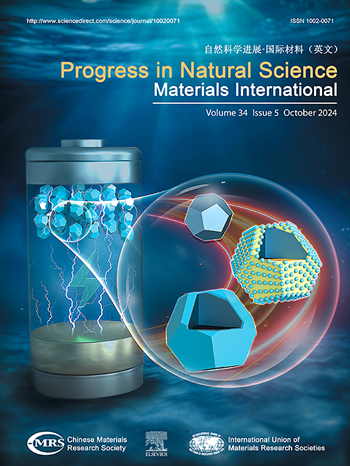Preparation of porous (Mo2/3Y1/3)2AlC and its hydrogen evolution reaction performance
IF 4.8
2区 材料科学
Q2 MATERIALS SCIENCE, MULTIDISCIPLINARY
Progress in Natural Science: Materials International
Pub Date : 2024-10-01
DOI:10.1016/j.pnsc.2024.09.002
引用次数: 0
Abstract
Porous (Mo2/3Y1/3)2AlC MAX phase ceramic was prepared by reaction sintering method using Mo, Y, Al, and graphite powder as raw materials. The influence of changes in Al content on the purity of the obtained samples was investigated using X-ray diffraction (XRD), scanning electron microscopy (SEM), Archimedes method, and bubble point method. The conditions for obtaining a pure phase were identified, and the transformation path of the phase during sintering and the mechanism of pore formation were provided. The linear sweep voltammetry (LSV) cure and cyclic voltammetry (CV) cure of MAX were tested using an electrochemical workstation. It can be calculated that MAX exhibits good hydrogen evolution reaction (HER) performance under alkaline conditions due to its high electrochemical active surface area (ECSA) of 373.2 and small Tafel slope of 41.7 mV·dec−1.
多孔 (Mo2/3Y1/3)2AlC 的制备及其氢进化反应性能
以 Mo、Y、Al 和石墨粉为原料,采用反应烧结法制备了多孔 (Mo2/3Y1/3)2AlC MAX 相陶瓷。利用 X 射线衍射 (XRD)、扫描电子显微镜 (SEM)、阿基米德法和气泡点法研究了铝含量的变化对所得样品纯度的影响。确定了获得纯相的条件,并提供了烧结过程中相的转化路径和孔隙形成的机理。利用电化学工作站测试了 MAX 的线性扫描伏安法(LSV)固化和循环伏安法(CV)固化。通过计算可知,MAX 在碱性条件下具有良好的氢进化反应(HER)性能,因为它具有 373.2 的高电化学活性表面积(ECSA)和 41.7 mV-dec-1 的小 Tafel 斜坡。
本文章由计算机程序翻译,如有差异,请以英文原文为准。
求助全文
约1分钟内获得全文
求助全文
来源期刊
CiteScore
8.60
自引率
2.10%
发文量
2812
审稿时长
49 days
期刊介绍:
Progress in Natural Science: Materials International provides scientists and engineers throughout the world with a central vehicle for the exchange and dissemination of basic theoretical studies and applied research of advanced materials. The emphasis is placed on original research, both analytical and experimental, which is of permanent interest to engineers and scientists, covering all aspects of new materials and technologies, such as, energy and environmental materials; advanced structural materials; advanced transportation materials, functional and electronic materials; nano-scale and amorphous materials; health and biological materials; materials modeling and simulation; materials characterization; and so on. The latest research achievements and innovative papers in basic theoretical studies and applied research of material science will be carefully selected and promptly reported. Thus, the aim of this Journal is to serve the global materials science and technology community with the latest research findings.
As a service to readers, an international bibliography of recent publications in advanced materials is published bimonthly.

 求助内容:
求助内容: 应助结果提醒方式:
应助结果提醒方式:


